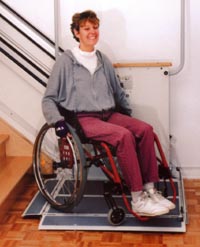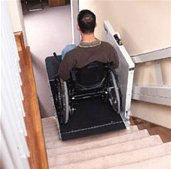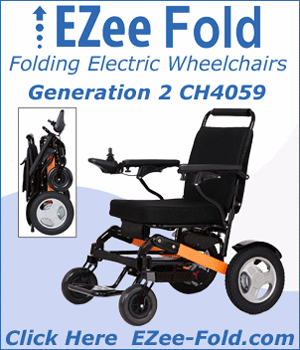Incline Platform Lifts

Incline platform lifts also known as platform stair lifts are platforms large enough to hold a wheelchair or a small to mid sized scooter. They travel up and down a staircase transporting wheelchair users between floors and while some models will negotiate curves, most are designed for straight runs. In cases where major renovations are being done to make a house accessible an elevator might be a better solution for about the same cost. In cases where there is a suitable staircase to use and major renovations are not planned this may be the best option dollar for dollar.
The biggest issue faced when purchasing a incline platform lift is the installation. If the stairway is suitable, the installation can proceed without much fuss but if not, some modifications may be needed which may be fairly extensive. For an incline platform lift to be easily installed the stairway must be wide enough, at least 34", preferably 36", there must be plenty of headroom, about 7 feet (measured at a 90 degree angle to the stair slope) all the way down past the bottom stair, at least 6 feet of open space at the bottom of the stairs, preferably 9 feet. and if the unit you purchase is wall mounted, the wall must be structurally sound enough to support the weight.
Another consideration is the weight capacity of the incline platform lifts. I had a client who hired an apparently experienced architect to design a fully accessible brand new home with an incline platform lift to get down into the basement. As soon as I met the the client I realised we had problems, he was about 300 lbs. sitting in a full power wheelchair with power tilt and recline weighing about 350 lbs. His total weight in the chair exceeded the weight capacity of the incline platform lift by 150 lbs. Fortunately the builder was in the process of framing the inside walls and we were able to put an elevator shaft in without too much trouble or extra expense.

The lift itself has a safety flap at the end to prevent the wheelchair from rolling off the lift which folds down and becomes a small ramp down off the platform when reaching the bottom.
There should be a safety pan on the bottom of the platform which will prevent the lift from travelling down if the platform comes in contact with any type of obstacle. If the user's family is in the habit of leaving items on the stairs, they will have to be retrained.
Another feature which is a must if others are going to be using the staircase is a flip up option for the platform. If the platform can't be flipped up against the wall when not in use, there is no way for able bodied people to get past it on the stairway.
There are both battery powered models and models which are powered by the house wiring. As with stair lifts, the battery powered lifts will have to have their battery replaced every few years whereas a house wired unit is free of this type of maintenance but won't work in a power failure.
Call send buttons are also features of these lifts and are especially important in buildings where more than one person is using the lift or the user prefers to store the lift at one end or the other of the travel when not in use.


 Online Vendors
Online Vendors  US Online Vendors
US Online Vendors 
